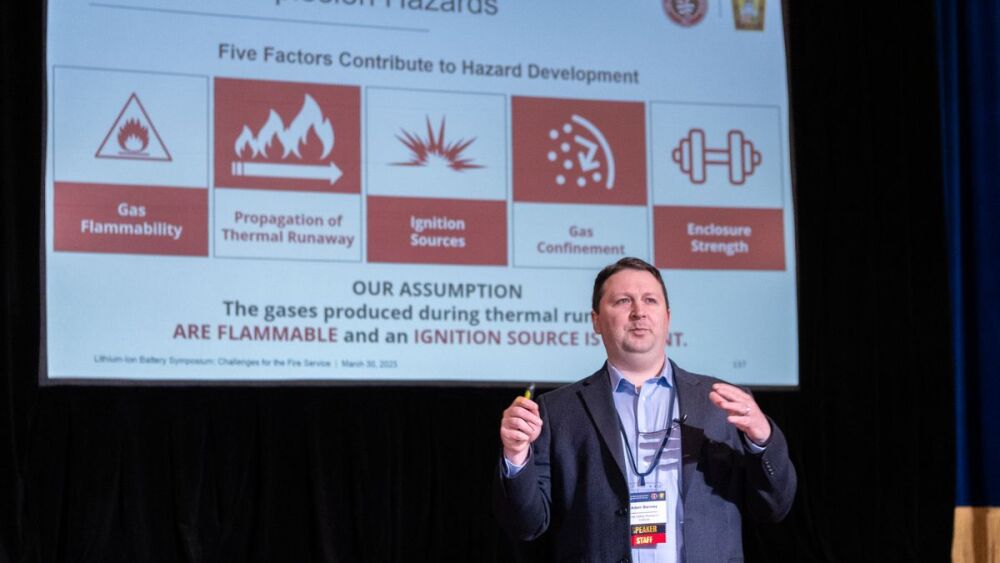Lithium-ion battery-related incidents are the biggest topic in the fire service today. If you follow battery-related incidents in the news, it seems these batteries are causing fires in e-mobility devices, consumer electronics and electric vehicles every day across the country.
On March 30, the District of Columbia Fire and EMS Department (DCFEMS) and UL’s Fire Safety Research Institute (FSRI) co-hosted a full-day symposium for fire service members interested in learning more about lithium-ion battery risks during fire incidents. Approximately 300 people attended the event at the George Washington Masonic National Memorial in Alexandria, Virginia, to listen to fire safety researchers and fire service operational experts speak about the hazards that lithium-ion batteries pose to firefighters. The symposium was also streamed live to over 2,500 viewers.
The symposium was extremely informative. There were discussions about energy storage systems (ESS), FSRI research, NTSB investigations, lessons learned from FDNY lithium-ion incidents, and response efforts to electric vehicle incidents. I encourage everyone to watch the recording of the event when it’s posted on the FRSI website.
Key takeaways
Here are the top 10 takeaways from the symposium.
1. Data needed: While there appears to be a large issue with lithium-ion battery fires, there is very little data to confirm how large that problem may be. Further, while there is a lot of research being done on the topic of lithium-ion battery failures, there are a lot of struggles. Researchers are having a hard time reproducing test results. Most testing to this point has been small scale. We need solid research involving full scale testing to help drive code, policy and procedure.
2. Generally safe. Lithium-ion batteries are generally safe when used properly. Typical failures are caused by mechanical abuse, temperature abuse, charge/discharge cycles in older chemistries, electrical abuse and manufacturing defects. Ultimately, batteries that are well built and well cared for should never fail.
3. Energetic failure: Lithium-ion batteries that are fully charged between 75% and 100% will fail energetically. As the battery charge decreases below 75%, the failure becomes less energetic. Newer battery chemistries like lithium iron phosphate have a higher tolerance for failure; however, when they do fail, they release significantly more hydrogen when compared to some of the older chemistries.
4. Concerning experiment: UL’s FSRI intentionally overcharged an e-scooter in a closed bedroom during an experiment. The results were concerning:
- 0 sec: Start of Failure
- 13 sec: Smoke alarm activation
- 18 sec: Deflagration that blew out the window
- 25 sec: Flashover
In a typical fire involving ordinary combustibles, the time from door open to flashover is 60 seconds. In a fire involving a large lithium-ion battery pack, the time from door open to flashover is 25 seconds. In fact, depending on the size of the battery pack, deflagration (low-speed explosion) is possible. It is unlikely that an occupant in a closed space with a failure of this magnitude would have time to react or escape.
5. Garage hazards: A failure of an e-mobility device containing a lithium-ion battery pack in a garage can lead to deflagration, a low-speed explosion that produces about 3 psi of pressure inside of the garage. While this sounds insignificant, that type of pressure will exert approximately 50,000 pounds of force on a garage door and potentially turn the door into a large projectile.
6. Situational awareness: Due to the heat in a structure, fire crews need to be aware if they pass any e-mobility devices while advancing a hoseline. Lithium-ion battery cells exposed to temperatures above 250 degrees F have a high chance of failure. If a crew advances a hoseline past a device with a large battery, it is possible for that device to fail catastrophically behind the crew and block their means of egress.
7. ESS response: Energy storage systems are becoming increasingly popular. These storage areas, which contain lithium-ion batteries, can be as large as a shipping container. If the batteries fail, there is a significant possibility of deflagration. Using lessons learned from the APS explosion in Surprise, Arizona, crews at the AES Battery Warehouse fire in Chandler, Arizona, allowed the batteries to burn with little intervention. The fire started on April 18, 2022, and the scene wasn’t turned back over to the business owners until May 1, 2022. If you have a fire in an ESS unit, it will likely be a multi-day incident.
8. Vapor clouds: Lithium-ion battery packs of any scale can off-gas when they fail. If the pack is large enough, it is possible to arrive on scene to find a substantial vapor cloud hanging low to the ground. This is an extremely hazardous zone that NO ONE should be permitted to enter. A hot zone needs to be established and hazmat notified. A large vapor cloud indicates a major incident, and it could take multiple days to resolve safely.
9. Li-ion battery fire attack: Here are some tips for after a fire involving lithium-ion batteries:
- Always wear full PPE and SCBA when handling heat-affected battery cells. Battery cells can fail without warning, even if they appear to be cool when using a TIC.
- Fires involving batteries will likely show multiple ignition points during a fire investigation. This is because cells can be ejected from the battery pack during the fire and travel distances of over 100 feet.
- Battery cells need to be found and removed from the structure prior to overhaul. If cells are buried by drywall and other materials during overhaul, it is possible to have a secondary fire event days or weeks after the incident.
- Never move heat-affected battery cells in an elevator.
10. Outdated codes: Current building, electrical and fire codes are just barely keeping up with the shift to lithium-ion batteries. Even though the newest code does have provisions in these areas, most communities have not adopted these codes, instead relying on outdated codes that are silent on battery and charging technology.

(Left to right): Steve Kerber, Ph.D., vice president and executive director of UL’s FSRI; Captain Hunter Clare, Peoria, Arizona; Sean DeCrane, director, Fire Fighter Health and Safety Operational Services, IAFF; Fire Chief Michael O’Brian, Brighton Area Fire Authority; Judith Jeevarajan, Ph.D., vice president of research, UL; and Fire Chief Otto Drozd, executive secretary, Metropolitan Fire Chiefs Association.
Photo/Patrick Durham
More work ahead
The fire service is going to have to adapt as lithium-ion incidents continue to be an issue. While industry is researching safer battery chemistries, it will likely be years before these chemistries make it to consumers. And even when that does happen, we will have many aging legacy products in homes throughout the country. Training is key to keeping up with the latest methods to manage these types of incidents. Be sure to follow the ongoing research and training offered by UL’s FSRI to keep up with the most current research and tactical recommendations related to these unique hazards.













